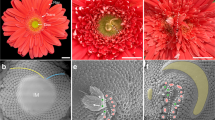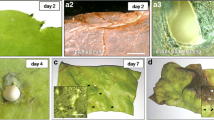Abstract
Microautoradiographic examination of wound-sieve tubes, formed after surgical interruption of a vascular bundle in the stem of Impatiens holstii Engl. et Warb, was conducted to investigate their structurefunction relationship in photoassimilate translocation. The irregular shaped wound-sieve tubes form tangential bridges connecting the wounded bundle with the intact neighbouring bundles. The wound-sieve elements differentiate in parenchyma cells which dedifferentiate and resume mitotic activity. Companion cells and various numbers of associated cells accompany the wound-sieve elements. Microautoradiographs of wound-sieve tubes were obtained from both cross and tangential sections after exposing the leaf above the wounded bundle to 14CO2. Labeled photoassimilates were found in woundsieve tubes, beginning about 6 d after wounding. Adjacent to completed wound-sieve tube bridges there are small complexes of isolated wound-sieve elements and incomplete bridges. Almost all wound-sieve elements contain the nucleus. Functionality of a wound-sieve tube is reached when its members are connected by sieve plates.
Similar content being viewed by others
Reference
Aloni, R. (1980) Role of auxin and sucrose in the differentiation of sieve and tracheary elements in plant tissue cultures. Planta 159, 255–263
Behnke, H.D., Schulz, A. (1980) Fine structure, pattern of division, and course of wound phloem in Coleus blumei. Planta 150, 357–365
de Stigter, H.C.M. (1961) Translocation of 14C-photosynthates in the graft muskmelon/Cucurbita ficifolia. Acta Bot. Neerl. 10, 466–473
Eschrich, W. (1953) Beiträge zur Kenntnis der Wundsiebröhrenentwicklung bei Impatiens holstii. Planta 43, 37–74
Evert, R.F., Eschrich, W., Eichhorn, S.E. (1971) Sieve-plate pores in leaf veins of Hordeum vulgare. Planta 100, 262–267
Fritz, E. (1980) Microautoradiographic localization of assimilates in phloem: Problems and new method. Ber. Dtsch. Bot. Ges. 93, 109–121
Hardham, A.R., McCully, M.E. (1982a) Reprogramming of cells following wounding in pea (Pisum sativum L.) roots. I. Cell division and differentiation of new vascular elements. Protoplasma 112, 143–151
Hardham, A.R., McCully, M.E. (1982b) Reprogramming of cells following wounding in pea (Pisum sativum L.) roots. II. The effects of caffeine and colchicine on the development of new vascular elements. Protoplasma 112, 152–166
Jacobs, W.P. (1970) Regeneration and differentiation of sieve tube elements. Int. Rev. Cytol. 28, 239–273
Kaan Albest, A.V. (1934) Antomische und physiologische Untersuchungen über die Entstehung von Siebröhrenverbindungen. Z. Bot. 27, 1–94
Kollmann, R., Yang, S., Glockmann, C. (1985) Studies on graft unions. II. Continuous and half plasmodesmata in different regions of the graft interface. Protoplasma 126, 19–29
LaMotte, C.E., Jacobs, W.P. (1963) A role of auxin in phloem regeneration in Coleus internodes. Dev. Biol. 8, 80–98
Mollenhauer, H.H. (1964) Plastic embedding mixtures for use in electron microscopy. Stain Technol. 39, 111–114
Robbertse, P.J., McCully, M.E. (1979) Regeneration of vascular tissue in wounded pea roots. Planta 145, 167–173
Schulz, A. (1986a) Wound phloem in transition to bundle phloem in primary roots of Pisum sativum L. I. Development of bundleleaving wound-sieve tubes. Protoplasma 130, 12–26
Schulz, A. (1986b) Wound phloem in transition to bundle phloem in primary roots of Pisum sativum L. II. The plasmatic contact between wound-sieve tubes and regular phloem. Protoplasma 130, 27–40
Spurr, A.R. (1969) A low viscosity embedding medium for electron microscopy. J. Ultrastruct. Res. 26, 31–43
Author information
Authors and Affiliations
Additional information
We are indebted to Professor Ray F. Evert (University of Wisconsin, Department of Botany, Madison, Wi, USA) for giving the first author (K.R.J.) the possibility and advice for preparing the electron micrographs. The authors thank Yaffa Grossman (University of California, Department of Botany, Davis, CA, USA) for critical review of the manuscript. Supported by the Graduiertenförderung of the University of Göttingen, and by Deutscher Akademischer Austauschdienst.
Rights and permissions
About this article
Cite this article
Ruth Jacobsen, K., Eschrich, W. Translocation of photoassimilates in wound-sieve tubes. Planta 181, 335–342 (1990). https://doi.org/10.1007/BF00195885
Received:
Accepted:
Issue Date:
DOI: https://doi.org/10.1007/BF00195885




